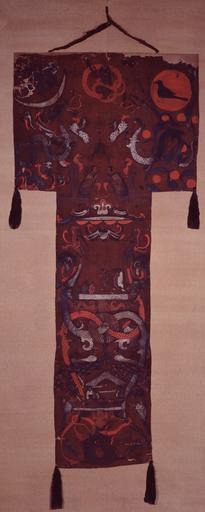MAKE A MEME
View Large Image

| View Original: | Mawangdui_silk_banner_from_tomb_no1.jpg (903x2250) | |||
| Download: | Original | Medium | Small | Thumb |
| Courtesy of: | commons.wikimedia.org | More Like This | ||
| Keywords: Mawangdui silk banner from tomb no1.jpg The painting on silk depicts the heaven upper part the human realm middle part and the netherworld bottom part Heaven Nüwa--depicted as a human with a serpent's body--is seen at the center The sun with its crow is seen at the right There are another eight suns depicted on the right The hare and toad on the moon is depicted on the left Chang'e flying towards the moon is depicted on the left A heavenly gate separating heaven and earth is depicted Dragons and guardians are depicted Human realm Xin Zhui--the deceased occupant of the tomb--is depicted traveling over the road to heaven while being accompanied by three maids of honor and welcomed by minor officials Two dragons interlocked by a jade disk are depicted Xin Zhui's family is seen offering sacrifices and prayers Netherworld Depicted here is a giant that stands on the back of whales while holding up earth Western Han period 206 BC ˆ’ 25 AD Three layers of silk<br/> One piece of silk sewn over the whole width of the center part<br/> A piece of silk sewn on each side of the upper part<br/> A bamboo stick at top wrapped by the silk<br/> Four tassels made from indigo flax thread 205 cm long<br/>92 cm wide at the top<br/>47 7 cm wide at the bottom Hunan Provincial Museum http //www hnmuseum com/hnmuseum/eng/collection/collectionContent jsp infoid 012fa0841dc9402884832f7093f210ee T-Shaped Painting on Silk 206 BC-25 AD Changsha Hunan Provincial Museum http //www hnmuseum com/hnmuseum/eng/specialExhibitions/gb/silkpic htm The T-shaped Painting on Silk Changsha Hunan Provincial Museum http //www hnmuseum com/hnmuseum/whatson/e_exhibitions/mwd/index html é©¬çŽ‹å †æ±‰å¢“é™ˆåˆ—å…¨æ™¯æ•°å—展厅 Changsha Hunan Provincial Museum object history Unearthed in 1972 <br/> At the Mawangdui Han Tomb No 1 during the evening of 25 April 1972 this T-shaped painting on silk was discovered on the coffin of the fourth layer Over the course of the following days it was carefully removed and secured for transport to the museum exhibition history A reproduction of this banner can be publicly viewed credit line This is a funeral procession banner During the Han dynasty people believed that the spirit would leave the body upon death becoming a wandering spirit The spirit was called back to the body before burial by this banner while the soul was restored by leaving the body in the coffin at home for a few days before burial to allow its return to the body The banner was placed in front the coffin and would be held up while the coffin was being carried guiding the spirit to the burial ground After the memorial ceremony the banner would be placed on top of the innermost coffin to be buried This way the spirit ascends heaven and the soul goes underground This traditional practice is still extant in some form today accession number place of creation China during the Han dynasty http //www hnmuseum com/hnmuseum/whatson/e_exhibitions/mwd/index html é©¬çŽ‹å †æ±‰å¢“é™ˆåˆ—å…¨æ™¯æ•°å—展厅 Changsha Hunan Provincial Museum <gallery> File Western Han Chinese Silk JPG Same banner File Banière funéraire peinture sur soie Chine jpg Same banner </gallery> other fields Different banner from tomb 3</gallery> PD-old-100 Silk textiles Paintings from China Mawangdui Textiles of the Western Han Dynasty Chinese silk Hunan Provincial Museum Xin Zhui Nuwa | ||||